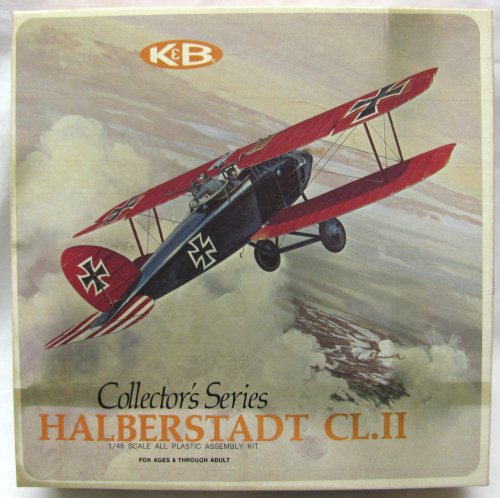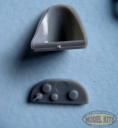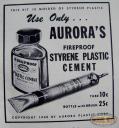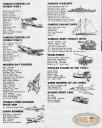By Fred Boucher and with Kit History by Alan Bussie
Kit History
In 1959
First release Halberstadt, #136-98
The kit proved successful, as were the vast majority of the WWI series. When
Second release Halberstadt with Parent’s Magazine Seal #136-98
The third issue still had the same part number but had the new
Third release Halberstadt, #136-98
The fourth issue, #136-130 looked identical inside and out except for the new price extension on the kit number. Retailers had been pressuring kit manufacturers to eliminate the price extension or raise prices; Aurora (USA) decided to first increase prices then eventually eliminated the extensions completely. This issue probably dates from 1963/64.
In 1972
1972 Fourth release K&B Halberstadt, #1136-200
In 1972 this kit was also released in
1972 Aurora Canada Halberstadt, #1136-260
This kit was marketed in other countries as well. One such issue is from the
The only other injection molded 1/48 Halberstadt CL.II kits I know of are the acclaimed Blue Max kit – now Freightdog Models – and one by Mirage. Tom’s Modelworks offered a high quality vacuform and metal kit at one time. Regardless, a quick spin around the net shows that this model can be built into a beauty!
This review is of an original 1960 model in a ‘long box’ dramatically decorated by the great artist Jo Kotula.
Parts Overview (click any to enlarge)
Inside are instructions, decals, and 42 parts injection molded in black and gray plastic. One piece is an identification button imprinted “HALBERSTADT CL-II
Part detail (click any to enlarge)
Test fitting reveals fair fit. Filler will be necessary along the fuselage and empennage. Care will also be required where the cabanes and interstruts mate into the airframe.
As was the fashion of the era, all insignia and data are molded onto the airframe. Removing it is a horrible exercise at best even on flat surfaces! Happily, by this time,
(Click to enlarge)
Accuracy
(click to enlarge)
Walk-Around
The provided 160 hp Mercedes D.III 6-cylinder water cooled inline engine has seven parts including the radiator pipe. Its detail is suggestive and lacks valve rockers, valve rocker shafts and pins.
The 7.92mm Spandau LMG 08/15 and Parabellum MG14 machine guns would be unrecognizable if you did not know what they were supposed to be. A scarf ring is provided for the Parabellum.
The cockpit is minimal and the pilot blocks seeing most of it. Only the floor, seat, and a slightly detailed instrument panel are included.
(click to enlarge)
Surface detail includes raised lines representing access hatches, control horns and control wire ports. A flush radiator and fuel tank adorns the top wing. There are several small parts for crash cages and other details.
Molded data on the fuselage includes weight and dimensional data as well as the aircraft type and serial data: Halb. CL.II 6438/18.
(click to enlarge)
Instructions, Decals And Paint Guide
(click to enlarge)
Decals include eight Balkenkreuz, green and white striped Schlachtstaffelen tail marking, aircraft number “5”, fuselage stripes and the fuselage serial “Halb. CL.II 6438/18,” identical to the raised markings on the fuselage. No dimensional data decals are provided.
(click to enlarge)
Conclusion
Another great trip to memory-drome! Even today this kit is sought for building and collecting. Some collectors enjoy building the kit as they did in the 1960s – straight from the box. Those who wish to build it to current standards will find it ripe for detailing and in need of serious surface sanding if you want to remove the insignia guide lines. One can buy several accurate modern kits for the price of one of these. No doubt you can make a respectable model with it, as evidenced by the many examples online. However, I would only buy and build one for nostalgia.
Built-up kit courtesy of Gil Hodges at HyperScale (click to enlarge)
History of the Halberstadt CL II
(From the instructions, using
In the late autumn of 1917, the Halberstadt CL II made an appearance on the Western Front. This two-seat fighter reconnaissance plane was powered by a 180 H. P. Mercedes motor. The main spars and ribs of the wings were spruce, internally and externally wire braced with a plywood leading edge. The fuselage was a wooden structure with center section struts of steel tubing. Both the fuselage and wings were fabric covered. A wooden frame-work made up the tail unit, fabric and plywood covered. The undercarriage consisted of rigid wooden ‘vees’ with rubber cord shock absorbers.
A fair sized plane, the Halberstadt CL II had an upper wing-span slightly over 35 feet while the length was just under 35 feet. The normal loaded weight was 2,532 Lbs. with an additional weapon load of some 550 Lbs. Performance was good with a speed of nearly 100 m. p. h. at 10,000 feet. Rate of climb progressed with 5,000 feet in just over 9 minutes; 10,000 feet in 24 minutes; 14,000 feet in 52 minutes. 13,500 feet was the service ceiling.
The armament included an external rack on the side of the fuselage for hand grenades when ground strafing. The observer had a single movable Parabellum machine-gun on a ring-mounting and the pilot used a synchronized
The British Infantry near Perrone in September of 1917 had physical contact against these two-seat fighters when the planes attacked with contact bombs and hand grenades. A specialty of the Halberstadt CL II was ‘contour fighting’ or close ground attack following the con-tour of the trenches of the enemy.
Although not exceptional in high altitude performance, the Halberstadt had extremely good manoeuvrability when under 1,000 feet. This gave the ability to dodge ground fire, and with the thin steel plate fitted along the bottom of the fuselage for protection against ack-ack fire, the Halberstadt was formidable in ground-strafing.
This German fighter closely resembled a single-seat scout. The pilot and observer shared a communal cockpit giving instant recognition in observation and gunnery. The pilot had a wide range of visibility whereas the observer was furnished with a clear firing field. An unusual feature in a two seat plane was the one-piece elevator of the Halberstadt which give excellent longitudinal balance. Approaching from the air, the Halberstadt could move quickly and surely, creating havoc in the enemy lines.






























